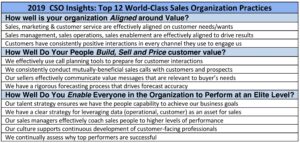

If you don’t know what “being customer-focused” means or can’t measure it, you can’t know if you’re doing it. Many company leaders desire customer focus. Fewer know exactly what that term means. Fewer still can describe specific behaviors to know how far they’ve progressed on a journey toward customer focus. Let’s fix that in this article.
The term “customer focus” is too vague to measure accurately. Let’s correct our target term to customer-perceived value. Perceived value is what drives customer decisions. Perceived isn’t just a throwaway word: value only exists in the customer’s mind, and elite organizations don’t take chances with what is/isn’t perceived by a prospect. Thus, customer-perceived value (I often shorten it to just “value” because there isn’t any other kind) is the core idea — the essence — within the cruder “customer focus”. Value is the axis around which everything in your organization should move.
Your first task in grading your company’s “customer focus” is to use a measurable target.
Refine your focus to “customer value”.
Value is the desirability of customer outcomes. Customers buy outcomes, not our products and services. What they are willing to pay – value — depends on the desirability of those outcomes. Desirability can be measured in dollars.
As you focus on value, your journey takes place in three domains, described below.
For starters, let’s grade your performance using three levels beyond “average”: Good, Great, and Elite. I’ll be detailing what Good, Great, and Elite look like in three upcoming articles, one for each domain. If you can’t wait, contact me, because those articles are already (mostly) written. I’m also developing an assessment tool, which will be on my new website (a shameless tease for coming attractions).
Below, I want to describe the three domains:
1. How well is your organization aligned around Value
Alignment between departments amounts to de-siloing your organization. I’m all for developing robust expertise in many specialties, but it is an established anthropological fact that silos also create gaps for important stuff to fall through. There is a constant push-pull between specialization and holistic/systems thinking in any organization. Alignment is the process of purposeful coordination between silos.
Companies usually start by aligning islands of functions…say, sales and marketing…then maybe customer service. In elite value focus (aka Radical Value focus, the title of my upcoming book) everyone wants to uncover new/better customer outcomes to increase value.
Customer experience (aka CX) management follows a similar track. Radical not only means everyone delivers value but is constantly seeking additional customer’s -mind insights
2. How Well Do Your People Build, Sell and Price customer value?
This is the domain of customer engagement. As you progress from “good at sales” to “elite value-based seller”, the skills deepen, and the number of people in the organization participating widens. I use three key components of the selling process to describe value-based selling:
- Build: Uncovering and discovering value gaps, expanding them, and causing the customer to envision outcomes of having those gaps resolved.
- Sell: Aligning the seller’s solution with desired customer outcomes.
- Price: Facilitating the customer process of monetarily measuring the desirability of outcomes, then conducting a win-win pricing dialogue.
Elite performers, those who have radical focus, are able to execute sales at more profitable value-based pricing.
How Well Do You Enable Everyone in the Organization to Perform at an Elite Level?
Enablement consists of hiring, training, coaching, and content services. Maturity level increases with the number of services, who is included, and breadth/depth of service. More importantly, maturity increases with transitioning from event focus, to process-focused, to closed-loop process.
- Event might mean train and coast, or coaching “burst”, then coast.
- Process looks like ongoing training; developing a coaching cadence.
- Loops close when coaching drives changed training when sales insights are captured for improved content and product innovation. The more loops closed, the more elite.
One way the journey starts is when a company realizes that front line sales managers performing as “super salespeople” or “deal saviors” doesn’t scale — or build bench strength — nearly as well as coaching everyone to save their own deals. Another key indicator of maturity is the organization’s discounting process and behavior, from subjective/”squeaky wheel” management to objective, value-focused and tracked/analyzed
Research Backs This Up.
CSO Insights (CSOi) has defined 12 behaviors of great companies (their term: “world-class”). “Great” organizations practice all 12. I’ve organized the 12 behaviors into these three domains. (Source: CSO Insights’ 2019 Sales Best Practices Study)
The difference between CSOi’s results and the elite behaviors I’ll be sharing in coming articles: CSOi never even asked about elite behaviors, and thus never correlated elite behaviors to results. The CSOi 12 behaviors figure prominently in the good and great levels of value focus, but are largely absent from the elite level.
- Do you want to win more opportunities than most? CSOi’s results show that practicing these 12 behaviors correlates strongly to that type of outcome.
- Do you want to win with higher customer preference? CSOi didn’t ask; their results are silent here. It neither corroborates nor refutes that higher perceived value correlates with higher preference. Other research (and common sense) will back this up, though.
- How about winning with higher value, driving deeper customer relationships? CSOi didn’t ask. Other research declares this a worthy pursuit, however.
- Selling at higher win-win prices? CSOi didn’t ask. There’s a sad story, here. Ask me about it sometime.
I Want More for You. Radically Elite Value Focus.
These are the three domains for a journey to elite value focus. In follow-on articles, I describe what makes up good, great, and elite performers.
Comment below, like, and/or share. As I said, reach out if you have more in-depth questions, or read the next three articles.
To your success!



